Global Humanitarian Assistance Report 2020: Chapter 3
Funding for effectiveness and efficiency
DownloadsIntroduction: Funding for effectiveness and efficiency
To meet the needs of people affected by humanitarian crises, sufficient funding is crucial; but how assistance is delivered is also key to the effectiveness and efficiency of response. Change is evident in some aspects of how assistance is delivered but not all. Progress against key Grand Bargain commitments is uneven and reporting on these commitments remains inadequate.
How international humanitarian assistance is channelled to first-level recipients has changed little over the past five years. In 2018, most assistance (62%, US$15.6 billion) from government donors was provided to multilateral organisations. Well over three quarters of funding (89%) from private donors was channelled to non-governmental organisations (NGOs).
The Grand Bargain signatories committed to a 2020 target of at least 25% of international humanitarian assistance being passed to local and national actors as directly as possible. After slight growth since 2016, direct funding to local and national responders decreased in 2019, both as a proportion of total assistance (from 3.5% to 2.1%) and in absolute volumes (from US$782 million to US$444 million).
UN pooled funds enable a flexible response with collective impact. UN pooled funds received a record volume in 2019 of US$1,869 million, an increase of almost 25% from 2018. This was the sixth consecutive year of growth, with total funding more than doubling since 2013.
UN country-based pooled funds (CBPFs) allocated more than US$1 billion in 2019, more than doubling total allocations since 2015. NGOs continued to receive the bulk (71%) of CBPF funding in 2019, with funding to local and national NGOs increasing to almost 25% of total CBPF funding.
Unearmarked and multi-year funding provides recipients with greater flexibility and predictability. Data collected by Development Initiatives from nine UN agencies indicates that unearmarked funding received by these agencies has declined since 2015, in volume and as a proportion of total contributions.
Humanitarian assistance provided as cash or vouchers increased in 2019, both in volume and as a share of total humanitarian assistance. As in 2018, this increase was primarily driven by increases in volumes for UN agencies. Challenges remain, however, in reporting and tracking, including in the response to the Covid-19 (coronavirus) pandemic.
Channels of delivery for international humanitarian assistance
Figure 3.1: Consistent funding patterns, with most public assistance going to multilateral organisations and most private assistance going to NGOs
Funding channels of international humanitarian assistance, 2018
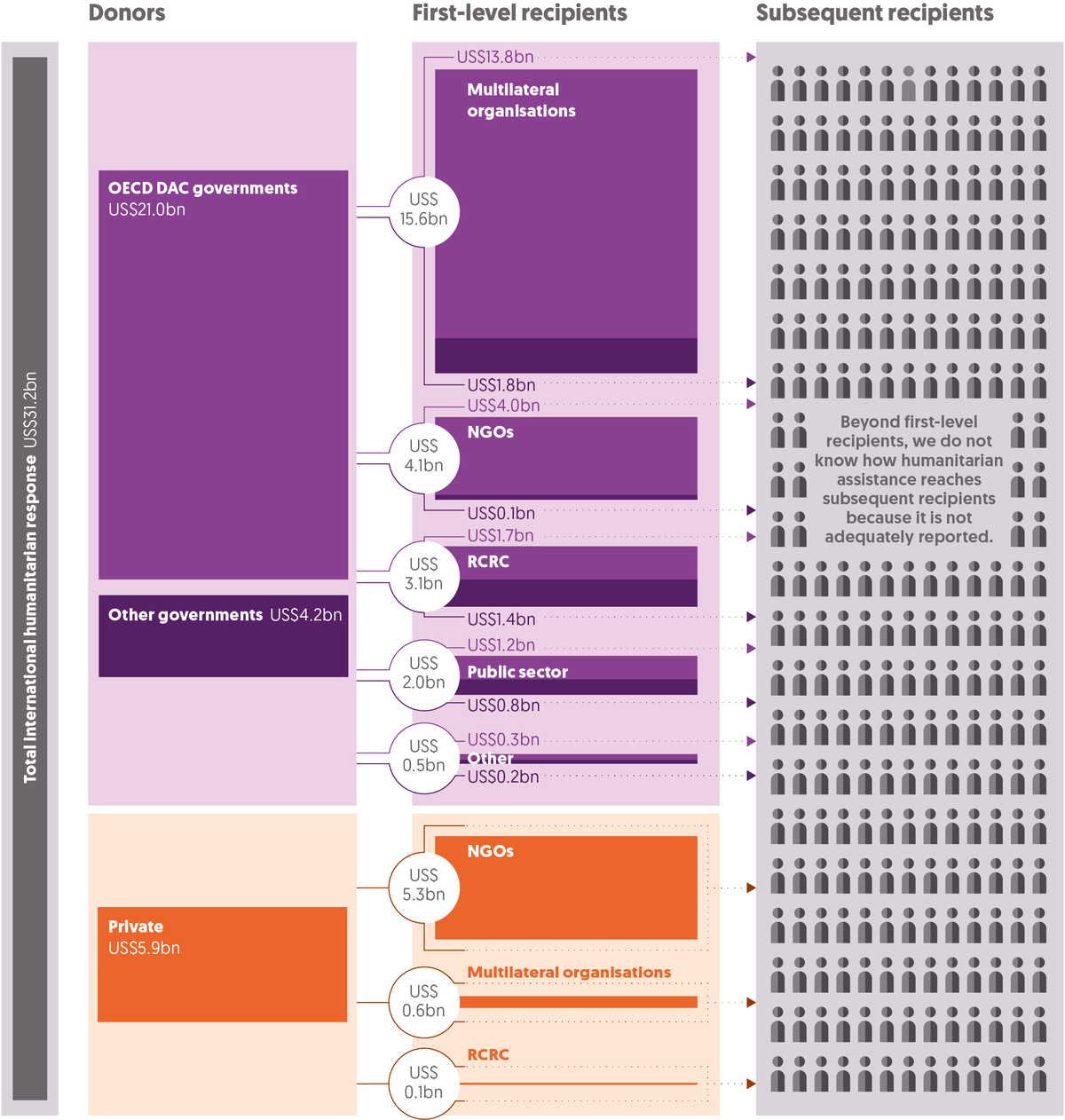
In 2018, governments directed almost two thirds (US$15.6 billion, 62%) of their international humanitarian assistance to multilateral organisations. In comparison, the bulk of international humanitarian assistance from private donors was directed to NGOs (US$5.3 billion, 89%).
Sources: Development Initiatives based on Organisation for Economic Co-operation and Development (OECD) Development Assistance Committee (DAC), UN Office for the Coordination of Humanitarian Affairs (OCHA) Financial Tracking Service (FTS) and UN Central Emergency Response Fund (CERF) data and our unique dataset for private contributions.
Notes: RCRC: International Red Cross and Red Crescent Movement. Our first-level recipient data from government donors and EU institutions uses OECD DAC Creditor Reporting System (CRS), CERF and UN OCHA FTS data. The figures in our calculations for total humanitarian assistance from OECD DAC donors use data from OECD DAC Tables 1, 2a and ‘Members’ total use of the multilateral system’, so totals may differ. ‘Public sector’ refers both to the OECD definition and reporting to the FTS. OECD DAC CRS codes ‘other’, ‘to be defined’ and ‘public–private partnerships’ are merged to ‘other’. Private funding figures use our unique dataset of private contributions for humanitarian assistance. Data is in constant 2018 prices.
As total humanitarian assistance increased in 2018, channels of delivery remained largely the same as in 2017. The majority of government assistance continued to be directed to multilateral organisations, while private donors channelled most of their assistance to non-governmental organisations (NGOs). This trend appears to have continued in the initial response to the Covid-19 pandemic, with most government funding to date directed to multilateral organisations (see Chapter 4, Figure 4.6 ).
Funding is often passed to one or more intermediaries before reaching a crisis location. Beyond funding to first-level recipients, there continues to be a lack of data on subsequent transactions (see Chapter 4, Box 4.4, How can data on funding be traced from donor to final recipient?).
- In 2018, governments directed almost two thirds (US$15.6 billion, 62%) of their humanitarian assistance to multilateral organisations. This is a decrease as a proportion of total assistance from 63% in 2017, but an increase in volume from US$14.6 billion. This proportion has remained relatively steady over the last five years, ranging between 58% in 2015 and 64% in 2014. By volume, this amount has increased each year from US$11.6 billion in 2014.
- Governments directed 16% (US$4.1 billion) of their humanitarian assistance to NGOs in 2018. This proportion decreased from 20% (US$4.6 billion) in 2017.
- The bulk of international assistance from private donors was directed to NGOs in 2018, with 89% (US$5.3 billion) of private funding received by NGOs. Private contributions comprised over half of the total funding to NGOs in 2018, with 56% of humanitarian assistance received by NGOs coming from private donors.
- International humanitarian assistance from private donors to multilateral organisations grew from US$467 million in 2017 to US$551 million in 2018. This represented a slight growth in the proportion of private donor funding going to multilateral organisations, from 8% in 2017 to 9% in 2018.
Funding to NGOs from all donors as a proportion of total international humanitarian assistance decreased from 35% in 2017 to 30% in 2018.
Direct funding to local and national actors
Figure 3.2: Direct funding to local and national actors decreased significantly in 2019 in volume and as a proportion of total funding
Direct funding to local and national actors reported to UN OCHA FTS, 2016–2019
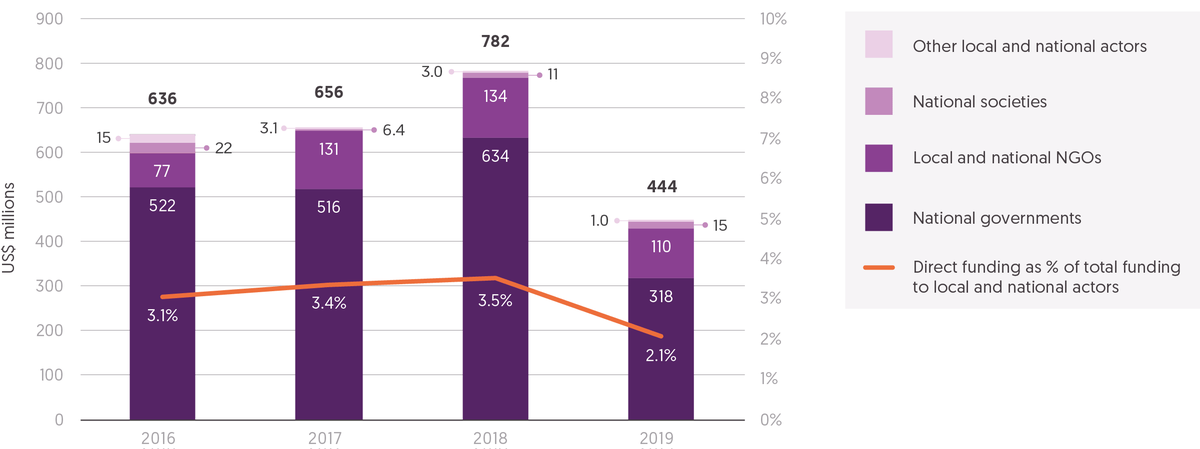
International humanitarian assistance sent directly to local and national actors as a proportion of all international humanitarian assistance decreased in 2019, with 2.1% (US$444 million) directed to local and national actors, decreasing from 3.5% (US$782 million) in 2018.
Source: Development Initiatives based on UN OCHA FTS data.
Notes: Data is in constant 2018 prices. National Societies: National Red Cross and Red Crescent Societies. RCRC National Societies that received international humanitarian assistance to respond to domestic crises are included in national actors. For organisation coding methodology, see our online ‘Methodology and definitions’.
The Grand Bargain set a 2020 target of at least 25% of international humanitarian assistance being passed to local and national actors as directly as possible. [1] This was followed by a subsequent agreement that this should relate to funding passing directly, and indirectly, through one intermediary. [2] Reporting of indirect funding, however, continues to be partial and incomplete.
Where comprehensive data is available on direct funding, it shows two consecutive years of small increases in 2017 and 2018. In 2019, there was a decrease in assistance sent directly to local and national actors as a proportion of all international humanitarian assistance. Absolute volumes sent directly to local and national actors also dropped significantly in 2019, down 30% from 2016 when the Grand Bargain target was set.
- International humanitarian assistance sent directly to local and national actors as a proportion of all international humanitarian assistance decreased in 2019, with 2.1% (US$444 million) directed to local and national actors, decreasing from 3.5% (US$782 million) in 2018.
- National governments continued to receive the majority of direct funding to local and national actors in 2019, although this decreased in percentage terms from previous years. The proportion of direct funding to local and national actors that was passed to national governments dropped to 72% (US$318 million) in 2019, from 81% (US$634 million) in 2018. This reduction was largely due to a 65% decrease in funding received by the Yemeni government, dropping from US$470 million in 2018 to US$163 million in 2019.
- Local and national NGOs received 25% of international humanitarian assistance provided directly to local and national actors in 2019. This was a significant increase from 17% in 2018, and markedly up from 12% in 2016. The increase in the proportion of funding that local and national NGOs received in 2019 was not, however, due to increased funding, but rather was driven by the decrease in funding received by national governments.
- The volume of funding received by local and national NGOs decreased from US$134 million in 2018 to US$110 million in 2019. This drop is largely accounted for by a fall in funding to local NGOs from US$33 million in 2018 to US$5 million in 2019.
- The majority of the remaining 3.7% of international humanitarian assistance provided directly to local and national actors was directed to National Societies of the International Red Cross and Red Crescent Movement (3.5%).
Pooled funds
Figure 3.3: Total pooled funding increases significantly in 2019, by volume and as a proportion of total assistance
Total funding to UN-managed humanitarian pooled funds, 2010–2019
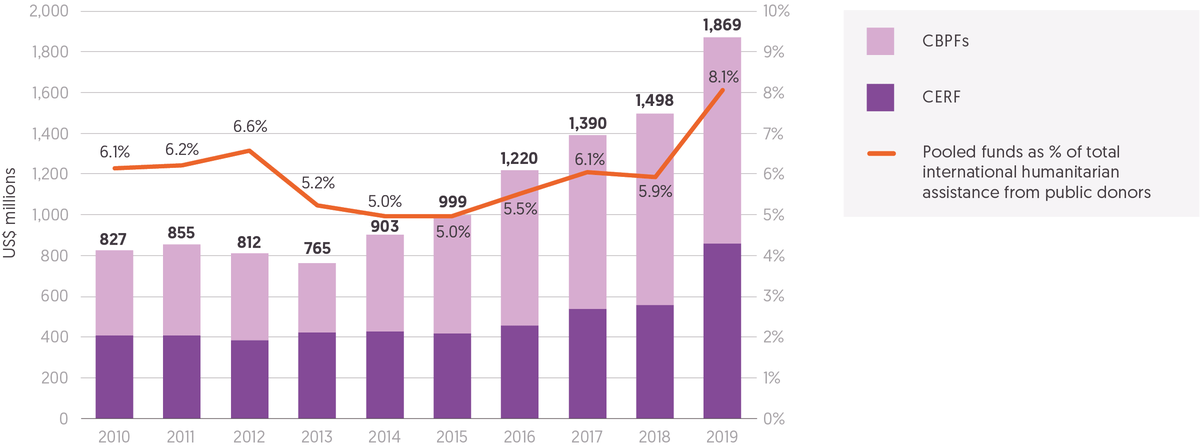
Funding to country-based pooled funds (CBPFs) increased by only 7% in 2019, from US$942 million in 2018 to US$1,009 million, while funding to the CERF grew by 55%, from US$555 million in 2018 to US$860 million in 2019.
Source: Development Initiatives based on UN OCHA FTS and UN CERF data.
Notes: CBPFs: country-based pooled funds (funding from emergency response funds and common humanitarian funds); CERF: Central Emergency Response Fund. Annual figures include carry-overs from the previous year. Data is in constant 2018 prices.
UN and NGO pooled funds combine contributions from different donors to enable rapid and strategic humanitarian responses. The pooled funds provide flexible funding that can be used where the need is greatest. Since 2013, total funding to UN pooled funds has more than doubled. As a proportion of total public contributions, however, funding to pooled funds has shown a slower increase over the same period.
- UN pooled funds received a record level of funding of US$1,869 million in 2019, an almost 25% increase from US$1,498 million in 2018. This was the sixth consecutive year of growth in contributions to UN pooled funds.
- The rise in 2019 was largely due to a 55% increase in funding to the Central Emergency Response Fund (CERF). Funding to the CERF grew from US$555 million in 2018 to US$860 million in 2019, making 2019 the fourth consecutive year of growth in funding to the CERF.
- Funding to country-based pooled funds (CBPFs) increased by only 7% in 2019, from US$942 million in 2018 to US$1,009 million. This was the smallest yearly increase in funding to CBPFs since 2013.
- In the 2010–2019 period, funding to UN pooled funds more than doubled, from US$827 million to US$1,869 million. As a proportion of total public contributions, funding provided to pooled funds notably increased in 2019 to 8.1%, up from 5.9% in 2018. Proportionally, the total public contributions to international humanitarian assistance that this represents had ranged between only 5.0% and 6.6% since 2010.
A small group of country donors is responsible for the majority of contributions to UN pooled funds.
- Five countries provided almost 75% of total contributions in 2019: the UK (US$357 million), Germany (US$173 million), Sweden (US$96 million), the Netherlands (US$64 million) and Belgium (US$50 million).
- In 2019, the UK increased its funding to the CERF by US$290 million. This more than tripled its previous year’s contribution, from US$114 million in 2018 to US$404 million in 2019. This increased contribution drove the overall increase in funding to the CERF in 2019.
Figure 3.4: UN-managed country-based pooled funds allocate a growing proportion of funding to NGOs
UN-managed country-based pooled funds by recipient type, 2015–2019
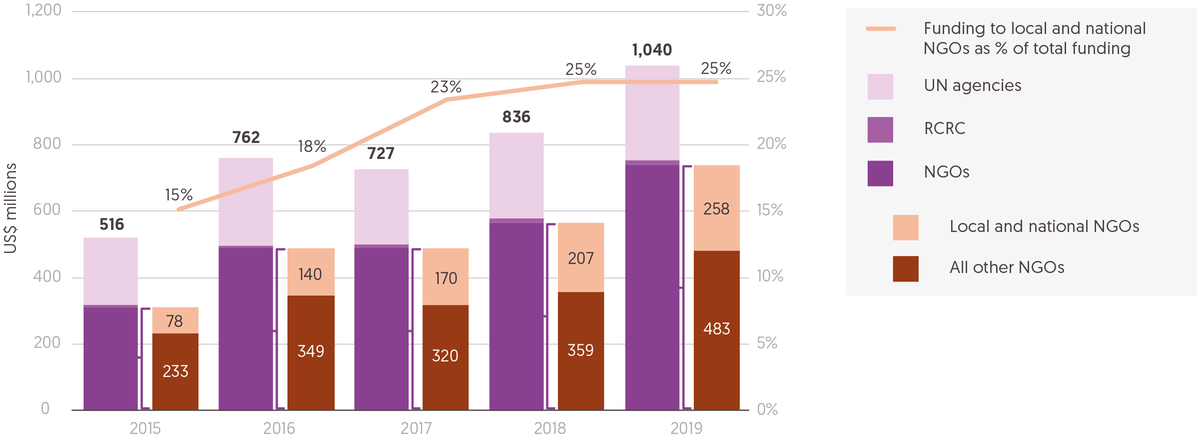
Over the period 2015 to 2019, the percentage of funding directed to local and national NGOs by UN-managed country-based pooled funds increased by 15% to 25%.
Source: Development Initiatives based on UN OCHA's CBPF Grant Management System.
Notes: Data is in constant 2018 prices. For organisation coding methodology, see ‘Data sources’.
UN-managed CBPFs respond to needs in specific country contexts. The funds are managed in-country and allocated to a range of implementing partners. NGOs receive more than two thirds of the funding allocated from CBPFs, and CBPFs are the largest single source of direct funding to local and national NGOs.
- Total allocations from UN CBPFs increased by 24% in 2019 to US$1,040 million. Since 2015, allocations from CBPFs have more than doubled, from US$516 million.
- Four CBPFs accounted for half of the CBPF allocations in 2019: Yemen (23%, US$244 million), Syria Cross-border (11%, US$118 million), South Sudan (7.8%, US$82 million) and Iraq (7.6%, US$79 million).
- NGOs received US$741 million (71% of total CBPF funding) in 2019, up from US$567 million (68%) in 2018. Since 2017, the volume of funding allocated to NGOs has increased year on year: rising 0.4% in 2017 and 15% in 2018.
- Of CBPF funding allocated to NGOs in 2019, 65% (US$483 million) was directed to international NGOs and 35% (US$258 million) to local and national NGOs.
CBPFs are an important source of funding for many local and national actors, with significant proportions of CBPF funding allocated to them. Despite this positive trend, funding to CBPFs remains only a small part of total humanitarian assistance, representing just 4% of total public donor contributions in 2019. This indicates that CBPFs are only part of the solution to passing more funding to local and national actors.
- Local and national NGOs are receiving an increasing share of the total allocations from CBPFs. In 2019, local and national NGOs received 25% of the total funding from CBPFs, rising each year since 2015 when local and national NGOs received a 15% share.
- This growth was largely driven by five CBPFs allocating increasing proportions to local and national NGOs: the occupied Palestinian territory Humanitarian Fund (a 738% increase in the 2016–2019 period), the Somalia Humanitarian Fund (628%), the South Sudan Humanitarian Fund (172%), the Yemen Humanitarian Fund (170%) and the Democratic Republic of the Congo Humanitarian Fund (74%).
- The proportion of allocations made to local and national actors varies between CBPFs. In 2019, the Iraq Humanitarian Fund allocated 0.9% (US$0.6 million) of its funding to local and national NGOs, while the occupied Palestinian territory Humanitarian Fund allocated 36.9% (US$6.2 million) of funds to local and national NGOs. The Somalia and South Sudan Humanitarian Funds also allocated around one third of their disbursements to local and national actors in 2019, allocating 34.4% (US$15.0 million) and 32.1% (US$23.4 million), respectively.
- The Yemen Humanitarian Fund allocated US$46.2 million to local and national NGOs in 2019 (19.2% of the fund’s total allocations), the largest volume of any CBPF.
- The volume of allocations from CBPFs to UN agencies increased by 11% in 2019 to reach US$286 million, rising from US$259 million in 2018. The total proportion of CBPF allocations directed to UN agencies has been consistently decreasing, however, dropping from 38% in 2015 to 28% in 2019.
Quality funding
Figure 3.5: Unearmarked funding to nine UN agencies fell by volume in 2019, and continues to fall as a proportion of total assistance
Earmarked and unearmarked humanitarian contributions to nine UN agencies, 2015–2019
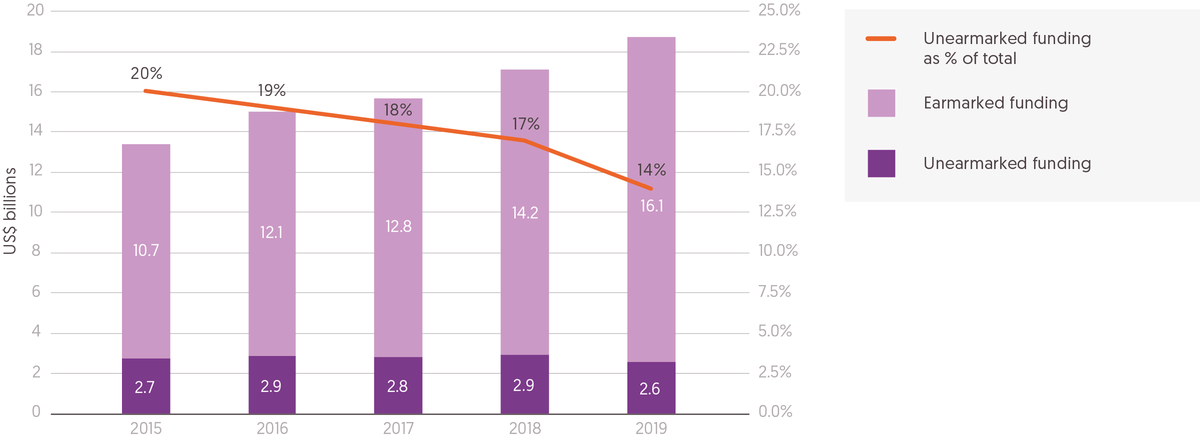
The amount of unearmarked funding as a proportion of total funding decreased each year, from 20% in 2015 to 14% in 2019.
Source: Development Initiatives based on data provided bilaterally by UN agencies.
Notes: The calculations comprise earmarked and unearmarked humanitarian and humanitarian-related contributions given to the Food and Agriculture Organization (FAO), International Organization for Migration (IOM), UN Development Programme (UNDP), UN OCHA, UN High Commissioner for Refugees (UNHCR), UN International Children’s Emergency Fund (Unicef), UN Relief and Works Agency for Palestinian Refugees in the Near East (UNRWA), the World Food Programme (WFP) and the World Health Organisation (WHO). Data is in constant 2018 prices.
‘Quality funding’ encompasses a range of properties that are valuable to different actors in different circumstances, and can include financing that is multi-year, unearmarked or otherwise flexible. The Grand Bargain set specific targets on multi-year and unearmarked funding; however, reporting and tracking progress against these aims remains challenging (see Box 3.2, What progress has been made on how multi-year funding and unearmarked funding is reported?).
Research published in 2020 by Development Initiatives, Multi-year humanitarian funding: global baselines and trends , [3] found that funding identified by 11 donors as multi-year had grown each year since 2016, both by volume and as a proportion of total humanitarian contributions.
Signatories to the Grand Bargain committed to “achieve a global target of 30% of humanitarian contributions that is non-earmarked or softly earmarked by 2020.” [4] Data collected from nine UN agencies indicates that unearmarked funding as a proportion of total funding has decreased steadily since 2015. The volume of unearmarked funding increased between 2015 and 2018, before dropping in 2019 to below-2015 levels.
- Between 2015 and 2019, unearmarked funding to the nine UN agencies decreased by US$140 million. The amount of unearmarked funding as a proportion of total funding decreased each year, from 20% in 2015 to 14% in 2019.
- The drop in the proportion of unearmarked funding in 2019 was driven by a 30% increase (US$1.7 billion) of earmarked funding to the World Food Programme (WFP), rising from US$5.7 billion in 2018 to US$7.3 billion in 2019.
- Only three of the UN agencies saw reductions in the amount of unearmarked funding between 2015 and 2019: the UN Relief and Works Agency for Palestine Refugees in the Near East (UNRWA) (a decrease of US$190 million, 24%), the UN International Children’s Emergency Fund (a decrease of US$66 million, 31%), and the UN High Commissioner for Refugees (a decrease of US$22 million, 2%).
- The three UN agencies receiving the largest volumes of unearmarked funding in 2019 were the UN High Commissioner for Refugees (US$1,280 million), UNRWA (US$596 million) and WFP (US$298 million).
- Five UN agencies saw an increase in unearmarked funding across the 2015–2019 period. The largest increases were to the WFP (an increase of US$60 million), the World Health Organization (an increase of US$32 million), and the UN Development Programme (an increase of US$21 million).
- Between 2015 and 2019, earmarked funding grew significantly, with the nine UN agencies reporting a cumulative increase of US$5.4 billion (an increase of 51%).
Box 3.1
The need to accelerate progress on quality funding
The Grand Bargain set out separate commitments on predictable and flexible funding. Since 2016, however, predictability and flexibility have increasingly been seen as complementary elements of humanitarian funding that can enable more efficient and effective programming. As a result, the workstreams on these two issues have merged to reflect this.
The scope of the quality funding agenda has also expanded beyond just multi-year and unearmarked funding to include elements such as reporting requirements, accessibility, timeliness, grant conditions and how funding is disbursed.
As research by Development Initiatives, the Norwegian Refugee Council and the UN Food and Agriculture Organization illustrates, there is a range of emerging practice across the humanitarian system that illustrates how different features of predictability and flexibility within funding arrangements are valued. [5]
For instance, multi-year core support to UN organisations (known as regular resources), consisting of unearmarked contributions given without restriction, was highlighted as enabling longer-term planning, allowing organisations to scale up sustainable solutions and adapt to changing situations in emergencies. The Programme Based Approach, in which donors provide softly earmarked funding at country programme level within multi-year framework agreements, facilitated timely and needs-based responses, allowing partners to adapt to changing priorities and opportunities.
Through the response to the Covid-19 pandemic, other examples are also emerging. The CERF responded swiftly to the pandemic, issuing single block grants to multilateral agencies. The grants range in volume from US$2.7 million to US$40 million and have been disbursed in two tranches, with allocations made within a maximum of five days from the date of agreement. The Start Network has also launched the Start Fund Covid-19, which provides access to a rapid response funding pool for NGO members of the Start Network. The fund operates windows where members raise ‘alerts’ to respond to identified needs. Funding is agreed within seven days of an alert being raised. By the end of June 2020, £4.9 million of funding had been released for 35 projects in 22 countries through the Start Fund Covid-19.
Further progress needs to be made, however. As a recent policy brief by the Norwegian Refugee Council highlights, [6] greater clarity is required on the concept of quality funding and how it is approached. Priority should be given to scaling up effective measures across all funding instruments, including flexibility, multi-year funding and other effective tools. The brief also identifies that donor concerns regarding accountability, reporting and visibility requirements need to be addressed.
Box 3.2
What progress has been made on how multi-year funding and unearmarked funding is reported?
It remains difficult to assess the extent to which Grand Bargain commitments are being delivered on multi-year and unearmarked funding. Reporting is limited and tracking systems not yet optimal. Defining what is to be tracked is key. For earmarked funding, the annex to the Grand Bargain contains definitions of earmarking categories. [7] The Enhanced Quality Funding workstream also published guidance in 2020, clarifying the shared definition of multi-year funding as lasting for 24 months or more. [8] There are two primary tools with which multi-year and unearmarked funding can be tracked: UN OCHA’s Financial Tracking Service (FTS) and the International Aid Transparency Initiative (IATI).
Tracking multi-year funding
The extent of reporting to both FTS and IATI is limited, given the lack of a common approach to interpreting definitions and reporting on funding. The FTS flow model allows identification of funding across multiple years by source and destination usage years. This permits the identification of a multi-annual funding flow (so spanning more than one calendar or financial year). If the yearly breakdown is also reported, it is then possible to identify the annual amount of funding. However, extracting summary figures on multi-year grants is not straightforward.
In 2019, 64 different organisations reported a total US$2.0 billion of multi-annual funding to FTS, compared to only US$300 million reported by 31 organisations for 2016. However, for many of these multi-annual flows, it is not possible to confirm that they definitely cover more than 24 months. IATI enables publishers to report at activity level with clear start and end dates, which can show multi-year projects. Given the absence of a widely endorsed approach to reporting multi-year funding flows, however, there is currently no standardised way to publish this information to IATI.
Tracking earmarked funding
FTS introduced the typology of earmarking categories from the Grand Bargain to its platform in early 2019. Already, for 2019 there is data provided by 189 organisations on the level of earmarking consistent with this typology, accounting for 84% of all funding reported to FTS for this year. However, in some cases analysis is hindered by the need to verify the reported level of earmarking between provider and recipient. IATI also allows identification of earmarking categories for individual transactions by specifying the aid type according to the Grand Bargain earmarking typology. Since the Grand Bargain, the quality of published earmarking data to IATI has improved slightly, but remains at a very low level. Only nine providers of IATI data publish data according to this typology (ADRA Denmark, DanChurchAid, UNHCR, Plan Bornefonden, Slovenia Ministry of Foreign Affairs, Voluntary Service Overseas, Leaders of Tomorrow, ActionAid UK and Netherlands Ministry of Foreign Affairs).
Remaining challenges
The destination of multi-year and unearmarked funding is critical, as is the extent to which it is transferred beyond first-level recipients. However, the traceability of this funding beyond first-level recipients remains challenging (see Chapter 4, Box 4.4, How can data on funding be traced from donor to final recipient?, in section on ' Channels of delivery for funding the Covid-19 pandemic response '). Predictable and flexible funding is not always clearly visible. For instance, while benefits to recipients are well-documented, is it also necessary to record programme outcomes, to determine the effectiveness and efficiency of this type of funding.
Cash and voucher assistance
Figure 3.6: Cash and voucher assistance grows by volume and as a proportion of total funding
Total international humanitarian assistance for cash and voucher transfers and programmes, 2015–2019
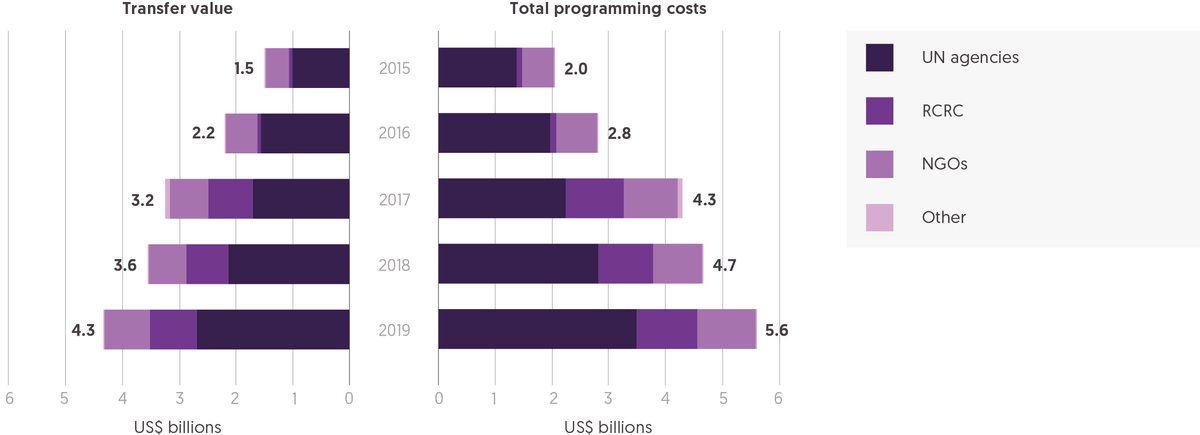
Both the volume of funding transferred to beneficiaries and the total programming costs of humanitarian cash and voucher assistance increased significantly in 2019, to US$4.3 billion (up 21%) and US$5.6 billion (up 20%) respectively from the previous year.
Source: Development Initiatives based on data provided bilaterally by implementing agencies, the Cash Learning Partnership and UN OCHA FTS.
Notes: Data for 2019 is preliminary. Double counting of cash and voucher assistance programmes that are sub-granted from one implementing partner to another is avoided where data was provided. Programming costs are estimates for organisations that provided only the amount transferred to beneficiaries. Data is not available for all included organisations across all years, for instance the RCRC started to systematically track cash and voucher assistance in 2017. Data is in current prices.
Humanitarian assistance provided as cash or vouchers can offer greater flexibility and choice to beneficiaries, compared with assistance provided as in-kind goods. Cash can empower recipients and help strengthen local markets. In the Grand Bargain, signatories agreed to “increase the use and coordination of cash-based programming”, [9] yet challenges remain in the reporting and tracking of the use of humanitarian cash and voucher assistance (CVA).
Available data (see Box 3.3, The potential of cash in responding to the Covid-19 pandemic) shows that the rate of growth of humanitarian CVA volumes continued uninterrupted in 2019, representing an increasing share of humanitarian assistance globally.
- Both the volume of funding transferred to beneficiaries and the programming costs of humanitarian CVA increased significantly in 2019, to US$4.3 billion (up 21%) and US$5.6 billion (up 20%) respectively from the previous year.
- As in 2018, this increase was primarily driven by increases in CVA volumes for UN agencies. This uneven growth across organisation types means the UN further accounted for almost two thirds (62%) of transfers to beneficiaries in 2019, compared with 53% in 2017. The WFP alone accounted for 38% of the humanitarian CVA transferred to beneficiaries in 2019 globally.
- All three organisation types (UN agencies, NGOs and the International Red Cross and Red Crescent Movement), however, increased their volumes of humanitarian CVA transferred to beneficiaries in 2019, by 25%, 21% and 12% respectively.
This growth in volume has outpaced humanitarian assistance more widely, such that humanitarian CVA has an increasing share of total humanitarian assistance.
- According to approximate estimates, CVA programming costs accounted for around 18% of total international humanitarian assistance in 2019, up from 14% in 2017 and 2018.
- This, however, is a comparison between inputs to, and outputs of, the international humanitarian system that are collected from two very different sources: donor data for international humanitarian assistance and implementing organisation data. A lack of reporting to interagency tracking platforms on how assistance reaches affected populations – in the form of services, cash and vouchers or in-kind assistance – means there is no data in between what donors contribute to humanitarian responses and how implementing organisations deliver assistance.
- The estimated percentage of humanitarian CVA transferred in the form of cash increased slightly from 2018 to 2019, from 74% to 75%. This slight growth follows a period of sustained increases in the use of cash assistance, with the proportion of cash used in humanitarian CVA rising from 55% in 2015 to 74% in 2018.
Box 3.3
The potential of cash in responding to the Covid-19 pandemic
In 2020, the Grand Bargain workstream on cash published guidance on how humanitarian CVA should be tracked at the interagency level. [10] Minimum requirements were set to track the amount of CVA transferred to beneficiaries, disaggregated as cash and vouchers. Despite this agreement, reporting of this information to the main interagency reporting platforms (UN OCHA’s FTS and the International Aid Transparency Initiative (IATI)) is still at a small scale and inconsistent. Over 90% of the data presented in this analysis is therefore collected directly from implementing agencies by Development Initiatives and the Cash Learning Partnership.
Humanitarian CVA can be an effective tool to respond quickly to exacerbated needs and has been recognised as a valuable instrument in the Covid-19 pandemic response. [11] Where the appropriate delivery modalities (such as mobile money or other digital systems) are available, the use of CVA can reduce mass gatherings and deliver assistance quickly.
As of 12 June 2020, a total of 133 countries had planned, introduced or adapted cash-based social assistance programmes in response to the Covid-19 pandemic. [12] This surge in social protection measures amplifies the opportunity for existing efforts [13] to better align humanitarian CVA with social protection programmes.
Due to the lack of reporting on the implementation of humanitarian CVA on real-time databases such as UN OCHAs FTS and IATI, it is not possible to gauge the volume of CVA used during the pandemic response. It is also not possible to track the crisis contexts in which CVA is currently used and – perhaps more importantly – where it could be used more. Increasing the amount of globally comparable CVA data on FTS and IATI is a crucial step towards improving coordination of the humanitarian response to a global humanitarian crisis of the scale of the Covid-19 pandemic.
Downloads
Download the PDF version of this report
Download the Global Humanitarian Assistance Report 2020
Download nowNotes
-
1
Grand Bargain signatories, 2016. The Grand Bargain – a shared commitment to better serve people in need. Available at: https://interagencystandingcommittee.org/system/files/grand_bargain_final_22_may_final-2_0.pdfReturn to source text
-
2
IASC Humanitarian Financing Task Team, 2018. Localisation Marker Working Group: definitions paper. Available at: https://interagencystandingcommittee.org/system/files/hftt_localisation_marker_definitions_paper_24_january_2018.pdf This paper defines ‘as-directly-as-possible’ funding as that passed through “a single international aid organisation” but notes that further research and discussion are planned to consider whether other intermediaries should be considered for inclusion.Return to source text
-
3
Development Initiatives, 2020. Multi-year humanitarian funding: global baselines and trends. Available at: /resources/multi-year-humanitarian-funding/Return to source text
-
4
Grand Bargain signatories, 2016. The Grand Bargain – a shared commitment to better serve people in need. Available at: https://interagencystandingcommittee.org/system/files/grand_bargain_final_22_may_final-2_0.pdfReturn to source text
-
5
Development Initiatives, FAO and NRC, 2020. Catalogue of quality funding practices to the humanitarian response. Available at: /resources/catalogue-quality-funding-practices-humanitarian-responseReturn to source text